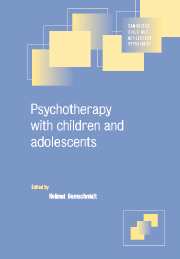Book contents
- Frontmatter
- Contents
- List of contributors
- Preface
- Part I Principles of psychotherapy with children, adolescents and families
- Part II Psychotherapeutic methods and settings
- Part III The practice of psychotherapy for specific disorders in childhood and adolescence
- 15 Anxiety disorders
- 16 Obsessive-compulsive disorder
- 17 Depressive syndromes and suicide
- 18 Dissociative [conversion] disorders
- 19 Disorders of sexual development and sexual behaviour
- 20 Substance abuse and addiction
- 21 Eating disorders
- 22 Psychotherapy in chronic physical disorders
- 23 Enuresis and faecal soiling
- 24 Dyslexia and dyscalculia
- 25 Stuttering
- 26 Hyperkinetic disorders
- 27 Autism
- 28 Schizophrenia
- 29 Conduct disorders, antisocial behaviour, delinquency
- 30 Physical abuse and neglect
- 31 Sexual abuse and sexual maltreatment
- Part IV The practice of psychotherapy in various settings
- Index
15 - Anxiety disorders
- Frontmatter
- Contents
- List of contributors
- Preface
- Part I Principles of psychotherapy with children, adolescents and families
- Part II Psychotherapeutic methods and settings
- Part III The practice of psychotherapy for specific disorders in childhood and adolescence
- 15 Anxiety disorders
- 16 Obsessive-compulsive disorder
- 17 Depressive syndromes and suicide
- 18 Dissociative [conversion] disorders
- 19 Disorders of sexual development and sexual behaviour
- 20 Substance abuse and addiction
- 21 Eating disorders
- 22 Psychotherapy in chronic physical disorders
- 23 Enuresis and faecal soiling
- 24 Dyslexia and dyscalculia
- 25 Stuttering
- 26 Hyperkinetic disorders
- 27 Autism
- 28 Schizophrenia
- 29 Conduct disorders, antisocial behaviour, delinquency
- 30 Physical abuse and neglect
- 31 Sexual abuse and sexual maltreatment
- Part IV The practice of psychotherapy in various settings
- Index
Summary
General considerations, definition and classification
The term anxiety disorder comprises a number of different clinical disorders, each of which is characterized by two features: overwhelming and inappropriate anxiety and avoidant behaviour. The avoidance of specific objects or situations is usually distinguished from generalised or nonspecific (‘free-floating’) anxiety. The former is associated with phobic disorders, the second with anxiety neuroses. In the last few years attempts have been made to refine this distinction, but these efforts have still failed to produce unambiguous classification of anxiety disorders. Table 15.1 shows the classification of anxiety disorders in ICD-10 (WHO, 1992). Phobic disorders are distinguished from other anxiety disorders. Two types of agoraphobia are distinguished (both with and without panic attacks).
This attempt at classification (Table 15.1) illustrates the difficulty in clearly discriminating between various anxiety disorders. In some cases classification is almost impossible, because a combination of phobic symptomsmay be present simultaneously. An alternative is to split the disorder into a component defining the situation and temporal characteristics of the anxiety which may be one or more of the following:
(i) phobic anxieties, i.e. fear of specific objects or situations, including agoraphobia, social and monosymptomatic phobias (also called simple phobias);
(ii) acute attacks of anxiety, which are not associated with a specific object or situation and occur as sudden attacks of anxiety in which physical symptoms predominate (panic disorders);
(iii) generalized anxieties, which last longer, i.e. days, weeks or months. They do not depend on specific objects or situations. This type of anxiety is also called ‘free-floating anxiety’.
Then the symptomatic characteristics of the anxiety can be considered, which may include aspects on one or more of the following planes.
- Type
- Chapter
- Information
- Psychotherapy with Children and Adolescents , pp. 243 - 275Publisher: Cambridge University PressPrint publication year: 2001



